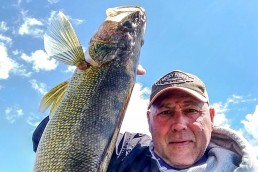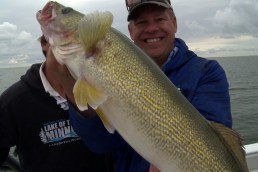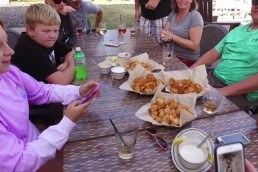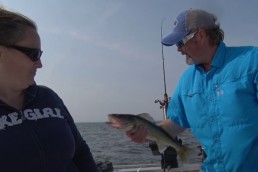Summertime Walleyes in Lake Erie
SHARE THIS POST
Many anglers in the Midwest have made a trip to Lake Erie for its great walleye fishing. I try to make one spring trip, and another trip in the fall. I constantly have Wisconsin fishermen asking about the fishing at Lake Erie because of the stories they’ve read and tall tales from friends who have made the trek to Ohio. Walleye fishing in Green Bay has improved tremendously in the last decade, and is a wonderful fishery if you don’t want to drive the eight hours to Lake Erie. But, for overall size and numbers, I still would recommend the waters of Erie.
If you’re planning a trip out east, I’m going to give you a few locations, techniques, and equipment that are time tested and have worked for me and friends.
Troll time
Anglers flock to Lake Erie in the spring and summer for the “hot bites.” Still, few anglers talk about the good fishing that there is during the summer months. The fishing technique in the summer is deep water trolling in many of the same locations one would fish in the spring and fall.
There three distinct schools of migrating walleyes are in the western, central, and eastern basins of the lake. Each migratory school has distinct travel routes that they travel along at different times of the year, chasing the schools of gizzard shad and emerald shiners. The Basin that I’m going to concentrate on is the Western Basin, because this is the area I fish and know best. The Western Basin starts on the west end of Lake Erie, near the famous Detroit River, and goes east to the Port Clinton and Marblehead area.
Early in the season, the schools of walleyes are concentrated in the reef area near the Camp Perry Firing Range, off the town of Port Clinton, and near the Bass Islands. As the water warms, the walleye schools move to deeper water, and usually suspend in the top 15 feet of the water column. The introduction of the zebra mussel has cleared the waters of the lake tremendously. The clearer water has forced most anglers to change their fishing techniques to catch fish. In the past, summer walleye anglers casted weight forward spinners and crawlers for walleyes. Now, the clearer water has made trolling with planer boards the most accepted technique, and probably the most effective.
Are you enjoying this post?
You can be among the first to get the latest info on where to go, what to use and how to use it!
Luring them in
Trolling with long rods, planer boards (Off Shore’s OR-12s), crankbaits, spoons and crawler harnesses with blades is now the way to catch Erie’s big ‘eyes. In some locations, it is necessary to get down to 30 to 40 feet over deeper water to catch these summertime walleyes. It’s difficult to find any crankbait that will run 30 feet deep by itself. So, it’s often necessary to use snap weights, dipsey divers or jets to get to the desired depth. Check all these diving devices out because they can often get you down to where the summer walleyes are in warm weather. I’ve also seen boats using downriggers to get down deep. The Precision Trolling Guide book explains all there is to trolling and using the different diving devices. If you plan on doing any trolling then this book is a must!
Bottom bouncers rigged with a crawler harness and big #4 or #5 blades will give out vibration and sound to attract fish. A three- or four-ounce bottom will get you down in the deeper water where the fish are often located. The best crankbaits for the western basin are as follows: Mann’s Stretch Series in 15’s and 20’s, Reef Runners, Bomber Long A’s, Deep Thundersticks and Rapalas. Colors like silver/black, blue/black, firetiger, perch, and purple work well.
Rods, reels and line
I use long G. Loomis 941 rods, Daiwa SG27 line-counter reels, and Berkley Fireline (gets you down deeper with less line out) on all my rods. Depending on how many people are in the boat, I like to pull 2 or 3 planer boards on each side, varying the amount of line out on each to make sure the water column is covered from top to bottom. I look for walleyes and schools of baitfish in good areas on my electronics, trying to pay attention to details and where the walleyes are located. I also like to run a line up high for walleyes that are chasing shad near the surface that you’ll never see on your electronics. Have a good selection of crankbaits in all colors, and keep changing them till you find the combination that works.
Hot spots
Here are some good locations to try during the summer months if you want size and numbers. After spawning, some fish move into the Detroit River and continue upriver into Lake St. Clair and Lake Huron. As the water warms, walleyes move toward the cooler water around the Bass Islands and some even go to the central basin. This year, the western basin has been very good. Here are some good spots to try: 1) East of the town of Marblehead, there is a reef that is very accessible to even small boats. There’s water close to 40 feet deep that often has schools of walleyes in the area. 2) The deep water around Kelley’s Island holds numerous walleye schools looking for baitfish. The deep water outside of Airport Reef and Kelley’s Island Shoal is another trolling hot spot. Concentrate your electronics on the water deeper than 40 feet when looking for suspended walleyes and baitfish schools. 3) North of Kelley’s Island is an area called “The Bird,” or Gull Island Shoal. Again, look for walleye and baitfish schools. 4) As the summer progresses, walleyes will migrate back to the Bass Island area because of the cooler water. Try the deeper water around Mouse Island, South Bass Island, Middle Bass Island, North Bass Island, Rattlesnake Island, Green Island and the many reefs that surround the islands. These islands and reefs are all in close proximity to each other. You can fish most of these spots in the same day, if the wind is right. 5) West of the Bass Islands is a deep-water area called “The Flats.” Walleyes cruise this area during the summer. Some of the best walleye fishing has been west of West Sister Island, and on the gravel pit seven miles north of Ward’s Canal, and around the Toledo water intake. Spoons, cranks and crawler harnesses are all working.
Remember to talk to the locals and listen to the charter captains are usually on fish. The locations I have given you are good places to start.
MWO
SHARE THIS POST
Did you enjoy this post?
You can be among the first to get the latest info on where to go, what to use and how to use it!
Gary Engberg
If you have any questions or comments you may reach Gary Engberg at 608-795-4208 or garyengbergoutdoors.com.



